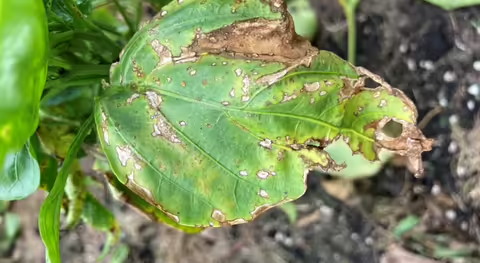Rainy weather is leaving gardeners confused. Traditionally, Illinoisans would be gearing up for a very hot and very dry late summer and I would be encouraging consistent watering as the key to good harvest. However, with the deluge of irrigation from the sky, there are some other landscaping tasks that need to be done to address the overwatering.
1. Identify and prune disease on vegetables
White powdery mildew proliferates in wet humid weather and can completely consume vine crops but also attacks ornamentals in your landscape like peony or zinnia.
At this point, remove infected leaves or increase air circulation. Avoid fertilizer as new succulent growth is more susceptible. Harvest is usually unaffected by leaf removal.
Gardeners may be noticing disease on their otherwise healthy tomato and pepper plants. Disease symptoms usually include discoloration of leaves and spots.
At this point, it is best to remove diseased leaves and leaves lower than 8-12 inches. Septoria Leaf spot is one of the most common diseases on tomato plants and Bacterial leaf spot is one of the most common disease on peppers. Both diseases overwinter in garden debris so be sure to get rid of plants after harvest. Be sure to never walk in your garden while the foliage is wet and disinfect your pruners between plants to prevent further spread. Fertilize after pruning to initiate new growth that will lead to more fruits.
2. Prevent mosquitoes by addressing standing water
As little as a half an inch of standing water can be the ideal breeding habitat of gardeners most detested visitor, the mosquito. It is important to know that mosquitoes don’t travel very far from where they were breed, less than a mile. So if you don’t want to be bitten by the female, anything that can hold water should be cleaned and emptied every week.
Lots of mosquitoes breed in the still putrid water of gutters, so cleaning gutters is one of the best things a homeowner can do to prevent uninvited guests to their backyard soirees. The larvae of these mosquitoes love cleaning stagnant water of bacteria, algae, and fungus.
3. Fertilize Yellow Plants
Sometimes leaves turn yellow because nutrients are unavailable in the soil. The microorganisms that usually break down organic matter into useable forms of nutrients to plants may not be present in the wet soil. Eventually, microorganisms will recolonize the soil to break down organic matter, but fertilizer treatment would give plants a boost.
PHOTO CAPTION: Bacterial Leaf Spot; University of Illinois Extension
ABOUT THE AUTHOR: Kelly Allsup is a Horticulture Educator for University of Illinois Extension serving Livingston, McLean and Woodford Counties. She meets the educational needs of her community, including local chapters of Master Gardener and Master Naturalist volunteers, through expertise in home horticulture and entomology. Her passion for ecologically-friendly gardening and all things plants makes her a dynamic speaker on topics that range from beneficial insects, growing vegetables and fruits, to urban trees.
